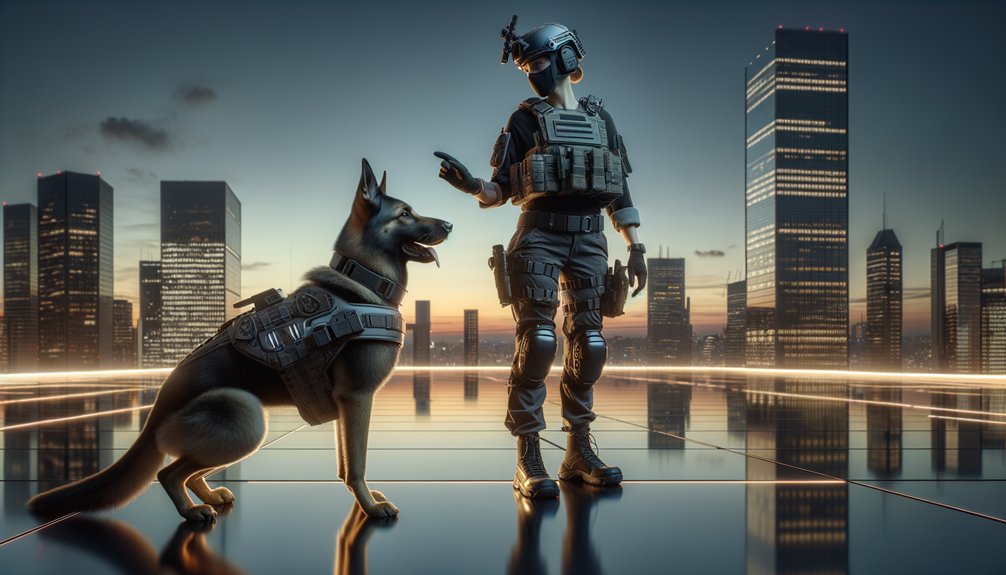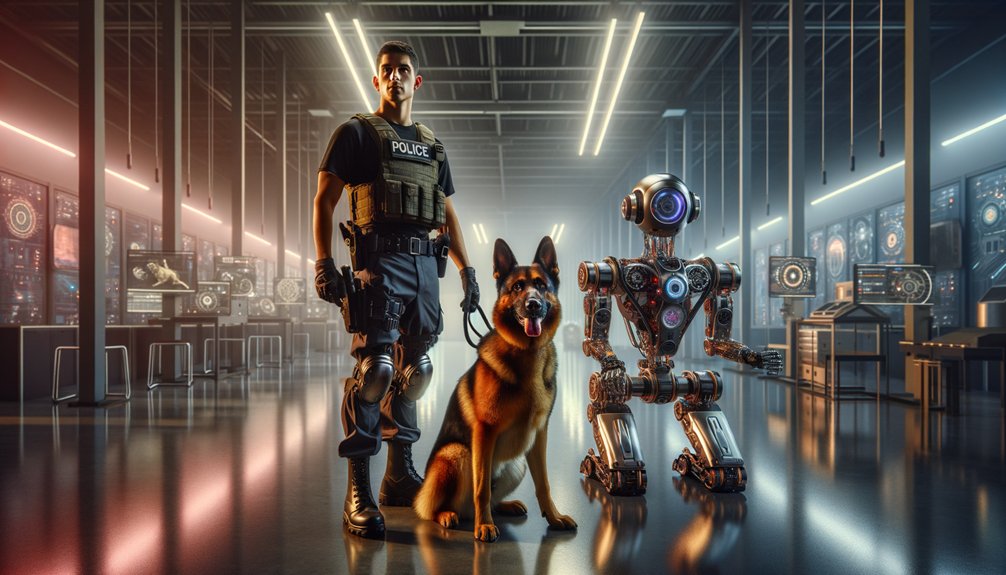The future of K9 training stands at a crossroads, where tradition meets technology in a dance of possibility. Old methods, steeped in history, echo the deep bonds formed between humans and their canine companions. Yet, the rise of innovative tools beckons a new era. As trainers explore these advancements, they unleash potential in ways previously unimagined. What might this harmonious blend reveal about the roles our loyal friends will play in the world ahead? Could the fusion of traditional K9 training methods with cutting-edge technology redefine our bond with dogs and unveil their untapped potential? Discover the possibilities.
Key Takeaways
- The integration of biometric tracking enhances health monitoring and performance evaluation of K9s, ensuring tailored training methods.
- Virtual training platforms provide flexible options, allowing handlers to access resources and knowledge from anywhere, bridging traditional techniques with modern needs.
- Advanced training tools refine K9 skills for roles in search and rescue, therapy, and law enforcement, adapting to contemporary challenges.
- The bond between handlers and K9s remains central, fostering effective communication and deepening the emotional connection despite technological advancements.
- Blending traditional training methods with modern innovations creates a balanced approach, honoring the legacy of canine training while embracing future possibilities.
From Tradition to Innovation

As the world evolves, the age-old training methods for K9s stand at a crossroads, merging with the innovations of modern technology.
This transformation invites a reflection on the rich legacy of canine training while highlighting the exciting potential of contemporary advancements.
The journey from tradition to innovation not only reshapes the way dogs are trained but also deepens the bond between humans and their loyal companions, provoking thoughts on how history and progress can beautifully intertwine.
Historical Training Methods
In the domain of canine training, a journey unfolds that traces the delicate balance between age-old traditions and modern innovations.
Historical training methods, steeped in ritual and respect, have long emphasized obedience training and the innate abilities of dogs, particularly in scent detection. Trainers, guided by instinct and experience, utilized techniques that fostered deep bonds between human and canine, nurturing trust and cooperation.
Through repetitive commands and rewards, they cultivated a sense of discipline that resonated through generations. The art of training was not merely a mechanical process; it was a dance of understanding, patience, and love.
As practitioners reflect on these foundational methods, they recognize their enduring impact, reminding us that the essence of training lies in the connection forged between species.
Modern Technological Advancements
While the roots of canine training lie in time-honored practices, the present landscape is shaped by remarkable technological advancements that transform the way humans and dogs interact.
Biometric tracking has emerged as a powerful tool, allowing trainers to monitor a dog’s health and performance with unprecedented accuracy. This data-driven approach fosters a deeper understanding of each canine’s unique needs, enhancing the bond between handler and dog.
Meanwhile, virtual training platforms offer flexibility and accessibility, enabling owners to engage in effective training sessions from the comfort of their homes.
These innovations not only elevate training standards but also evoke a sense of nostalgia for simpler times, inviting reflection on how tradition evolves while still honoring the deep connection shared with our canine companions.
Blending Tradition With Innovation
The journey of canine training unfolds as a rich tapestry woven from threads of tradition and innovation, each contributing its unique texture to the fabric of human-dog relationships.
As practitioners navigate this landscape, they find themselves at a crossroads where heritage preservation meets digital integration, fostering a deeper connection with their canine companions.
- Heritage Techniques: Techniques passed down through generations offer invaluable insights into the art of training.
- Technological Tools: Digital advancements, such as apps and training devices, enhance communication and understanding.
- Holistic Approach: Merging traditional practices with modern tools creates a balanced methodology, enriching the training experience.
This blend not only honors the past but also embraces the future, inviting practitioners to reflect on their journey and the legacy they create.
Tech in Action: New K9 Roles
Amidst the rapid advancements in technology, new roles for K9s are emerging, blending tradition with innovation in ways that spark wonder and curiosity.
These remarkable animals, long revered for their keen senses and loyalty, are now being trained through digital methodologies that enhance their innate canine capabilities.
With the integration of advanced training tools, handlers can refine skills to address contemporary challenges, from search and rescue missions to therapy roles in mental health support.
This evolution invites a reflection on the bond between humans and dogs, as traditional practices harmoniously intertwine with modern techniques.
As these new roles develop, they not only redefine the K9’s purpose but also deepen the emotional connections formed through shared experiences in service and companionship.
Modern Tactics with K9 Units
As law enforcement agencies adapt to the complexities of modern society, K9 units emerge as essential partners, seamlessly integrating into a variety of tactical operations. The bond between the handler and the dog is paramount, fostering effective communication that enhances both safety and efficiency.
Modern tactics leverage the remarkable capabilities of these dogs, particularly in:
- Scent Detection: Advanced training equips K9s to identify drugs, explosives, and even missing persons, proving invaluable in high-stakes situations.
- Crowd Control: K9 units provide a calming presence during public events, while their mere presence can deter criminal activity.
- Search and Rescue: Their acute sense of smell and agility enable rapid responses in locating individuals in distress.
Together, they embody a blend of tradition and innovation, evoking a deep sense of trust and admiration.


